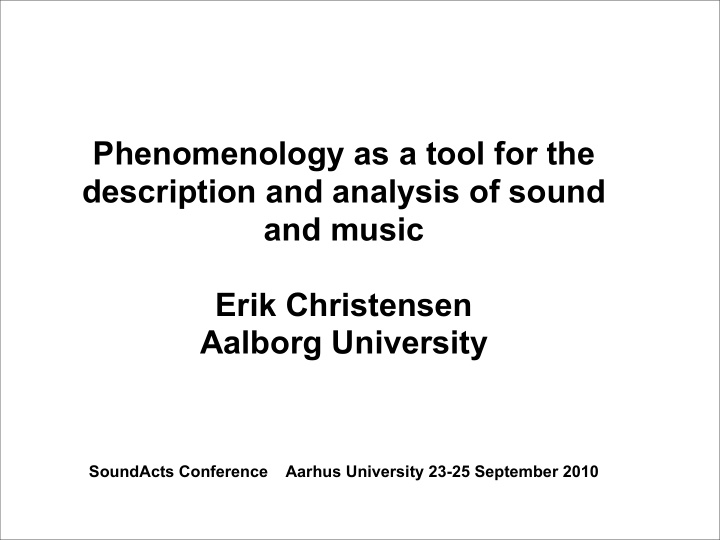



Phenomenology as a tool for the description and analysis of sound and music Erik Christensen Aalborg University SoundActs Conference Aarhus University 23-25 September 2010
Pioneers: Music Phenomenology: Thomas Clifton (1935-78) Lawrence Ferrara (b. 1949) Don Ihde (b. 1934) Neurology: Antonio Damasio (b. 1944)
Founders of philosophical phenomenology: Edmund Husserl (1859-1938) Martin Heidegger (1889-1976) Maurice Merleau-Ponty (1908-61)
Thomas Clifton (1983) Music as heard Phenomenon: Anything that appears to consciousness Some essences of musical phenomena: Time Space Feeling Motion Form Tone quality
Husserl’s phenomenology Direct description of experience: Let yourself be surprised by the world Avoid prejudices Think in beginnings Perform perceptual variations Perceive richness of experience Perception of Internal Time-Consciousness: Perception Retention Protention Immediate past Present Immediate future
Lawrence Ferrara (1984): Phenomenology as a Tool for Music Analysis ”One responds to questions posed by the music” 1. Open listenings 2. Listen for syntax (sound, material, texture) 3. Listen for semantic meaning 4. Listen for ontological meaning 5. Open listenings
Music Edgar Varèse: Poème électronique (1958) excerpt
Martin Heidegger’s phenomenology: ”Let the phenomenon show itself as it is in its Being” Existence: Being there in the world Interpretation is the meaning of phenomenological description History Culture Concern, Action
Thomas Clifton (1983) Music as heard Music is a bodily experience Body, that is: mind, feelings, senses, will, metabolism Music is a reciprocal relation between a person, his behavior, and a sounding object Primordial unity between self and music A centralizing self synthesizes the discrete perceptions of the body
Maurice Merleau-Ponty (1945) Phenomenology of Perception Perception is a bodily action Experience of the world is based on the unity of consciousness and body Meaning requires contribution from the body and from the world The senses are integrated in a unity The body’s knowledge of the world is pre-verbal
Don Ihde (1976, 2nd ed. 2007) Listening and Voice A theory of perception is a theory of the body Experience is global, the senses are integrated I hear with my whole body Music immerses, surrounds and penetrates the body The body participates in the movement of the music
Don Ihde: Listening and Voice Doing phenomenology: ”Let the things show themselves from themselves.” Perform phenomenological variations: Listen for Foreground and background Focus and fringe Motion and stability Attack and running-off Contact of surfaces Reverberations and interiors Directionality and surroundability The just-past (retention) and the expected (protention)
Antonio Damasio (1999) The Feeling of What Happens . Body and Emotion in the Making of Consciousness. Like emotion, consciousness is rooted in the representation of the body Consciousness begins as the feeling of what happens when we see or hear or touch Consciousness is an entirely private, first- person phenomenon
Antonio Damasio: The Feeling of What Happens Some clarifications: Emotions are about the life of the organism Emotions use the body as their theater Emotions are outwardly directed, public Emotions can engender feelings Feelings are inwardly directed and private Feelings can be made conscious Feelings perform their ultimate and longer-lasting effects in the theater of the conscious mind Core consciousness provides the organism with a sense of self about here and now: one moment and one place The core self is a transient entity, ceaselessly recreated Extended consciousness provides the organism with an elaborated sense of self: The autobiographical self
Antonio Damasio: The Feeling of What Happens The Sense of Self process, in brief: 1a. The organism is mapped in the brain 1b. An object is also mapped in the brain 2. The object mapping changes the organism mapping 3. The relationship between object and organism is represented as mental images (e.g. sight, sound, taste, smell, touch, inner sense) in core consciousness 4. Core consciousness provides a Sense of Self: The act of knowing. ”You notice yourself knowing”
References: Clifton, Thomas (1983) Music as Heard. A Study in Applied Phenomenology. New Haven: Yale University Press. Damasio, Antonio R. (1999) The Feeling of What Happens. Body and Emotion in the Making of Consciousness. London: Harcourt. Ferrara, Lawrence (1984) “Phenomenology as a tool for musical analysis”. The Musical Quarterly 70 (3), 355-373. Ferrara, Lawrence (1991) Philosophy and the Analysis of Music. Bridges to Musical Sound, Form, and Reference. New York: Greenwood Press. Ihde, Don (2007) Listening and Voice. Phenomenologies of Sound, 2 nd Edition. Albany, NY: SUNY Press. Merleau-Ponty, Maurice (1945) (English edition published 1962) Phenomenology of Perception. London: Routledge. Paperback edition, Routledge Classics 2002. Thøgersen, Ulla (2004) Krop og fænomenologi. En introduktion til Maurice Merleau-Pontys filosofi. Danmark: Academica.
Recommend
More recommend